Watching Black Oystercatchers in breeding season
By Jane Turner Hart
This past spring and summer I had the chance to observe a remarkable period of a Black Oystercatcher’s life: the nesting, brooding, hatching, protecting, feeding, and fledging of its chicks in the exposed, rugged territory of the rocky intertidal zone along the Pacific Coast.
In February, Noreen Weeden of Golden Gate Bird Alliance emailed me about volunteering to help with a survey project undertaken by Audubon California and others. The purpose was to collect baseline data on the Black Oystercatcher population, with a focus on the breeding and fledging success of pairs along California’s coast. How many eggs were laid in the nest? How many chicks would successfully fledge from that nest this year? In recent years, biologists have become more aware of the very small population size of Black Oystercatchers, thought to be about 10,000-12,000 individuals globally. Data suggest that the survival rate of their young has been dropping; they appear to have low reproductive success. I was definitely interested.
In late April, I began to head out to Land’s End in San Francisco where Black Oystercatchers had been seen recently.
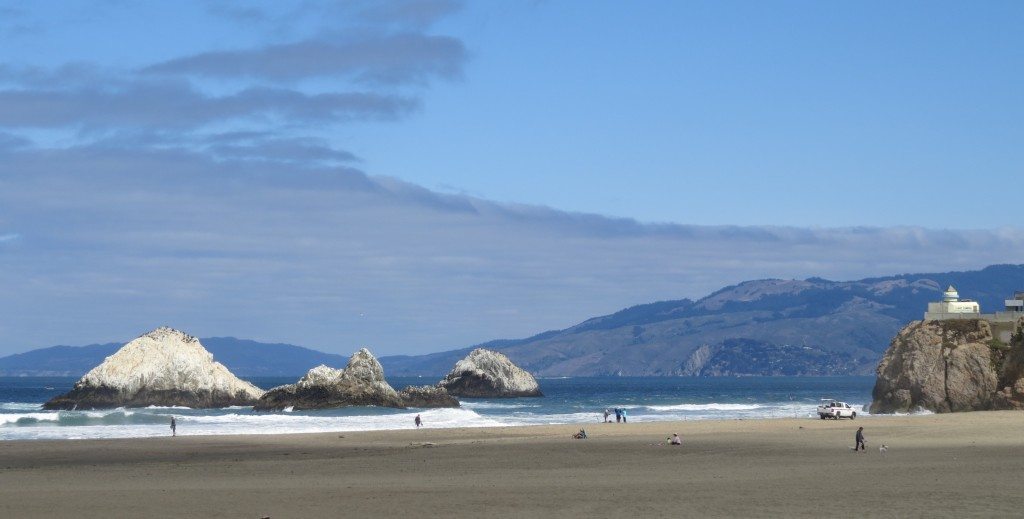
My early observations were from the back deck of San Francisco’s Cliff House. With a scope, binoculars and a smallish 50x Canon Powershot SX50 HS, I set up in the south corner of the deck to look west at three offshore rocks, collectively referred to as Seal Rocks. The distance from the deck to the rocks was roughly 450 feet.
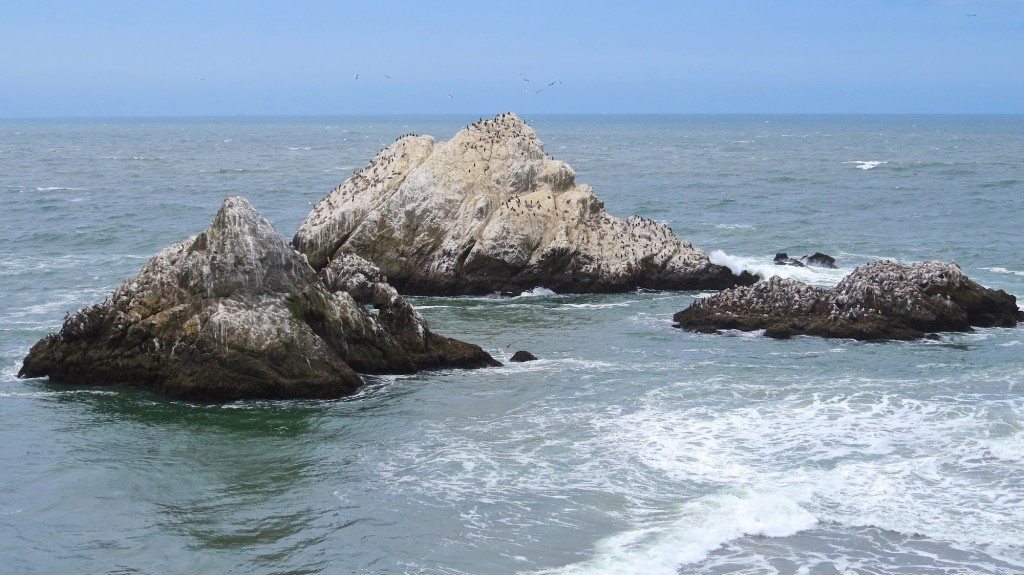
In Mid-April, I spotted a group of Black Oystercatchers flying north over the Seal Rocks. They circled the three islands, and two birds dropped down and landed on a sunlit bed of black and golden mollusks and limpets on Repose Rock.
The two black/dusky birds were difficult to see, except for their blood-red bills moving against the dark shell background. They walked slowly around the carpet of invertebrates, poking and pulling meaty bits from the mollusks. One of them stepped down into a deep pool of tidal water on the ledge, dunked its head in the pool several times, leapt out, shook off the drops, and then found a spot to sit and preen contentedly for several minutes.
I soon learned that Repose Rock was the Black Oystercatchers’ go-to spot for successful foraging at low tide.
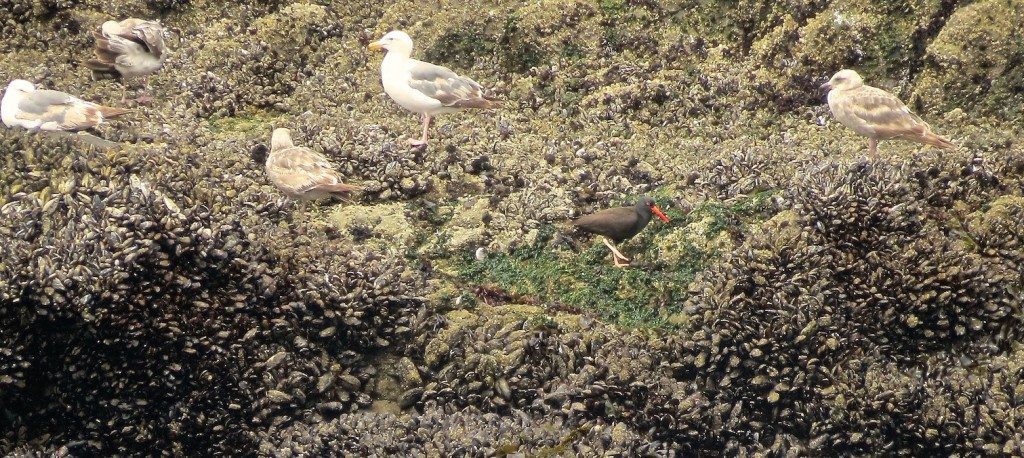
The Black Oystercatcher pair made themselves at home over the next few weeks. I watched them forage, explore around Land’s End, bathe, preen, sit together on the top of Cone Rock in the sun, and rest. Looking back, it strikes me that this three-week interlude may well have been a period of resting up and getting nourished and empowered for the challenges of incubation ahead.
Black Oystercatchers are monogamous and often lifelong partners. But as an observer of this pair, I had no way of knowing if the couple were new to parenting or an experienced couple. Had they nested before? Also, I could not distinguish between the male and the female. Their plumage is identical, and they are very close in size. One exception was in early May when I witnessed the male hop up on the back of the female to copulate.
On May 9, I watched the two adults explore potential nest sites on steep Cone Rock, move around gravel and small rocks there, and sit in different crevices. Of the three islands, Cone Rock made the most sense as a nest site. The least populated, it had few Western Gulls, which are known to be a predator of eggs and chicks. Arch Rock was crowded with a large colony of nesting Brandt’s Cormorants throughout the summer, several Western Gulls, and visiting Brown Pelicans. Repose Rock was a low island, sometimes covered with Western Gulls; at high tide it was often empty and hit by splashing waves.
By May 13, the pair had chosen a nest site. It was two-thirds of the way up the steep eastern side of Cone Rock. The site would help protect the nest from northwestern winds. The nest was a crevice between two slanting rocks extending back, with a small area where chicks might wander safely.
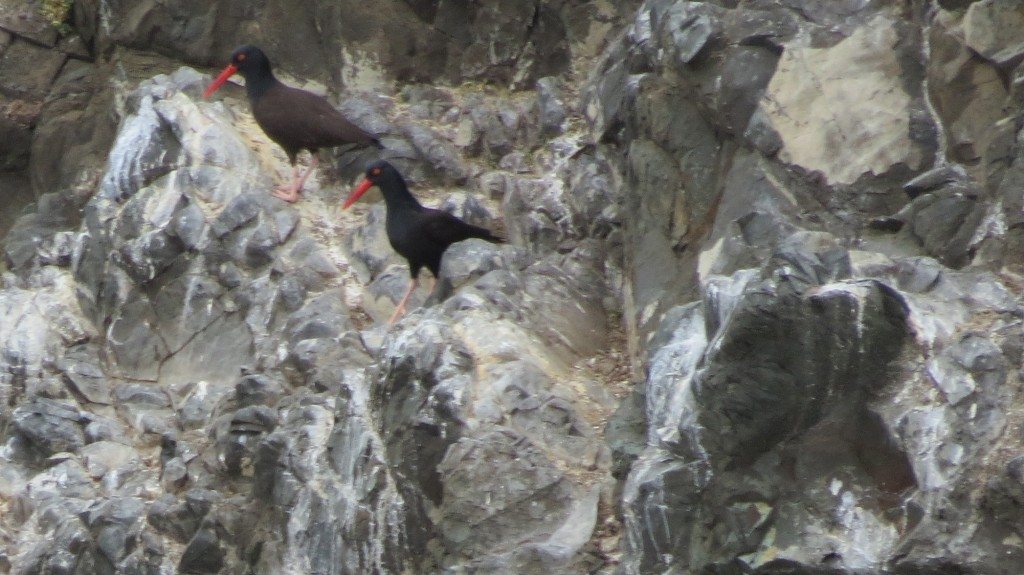
Both the male and the female participated in nest building, not a very long or strenuous activity. They appeared to be moving sand and gravel into a low scrape. Once or twice one of them sat in the crevice, seeming to try it out for comfort. The adult pair (dark marks on left) can be seen one-third of the way down from the top of the Rock at the nesting site.
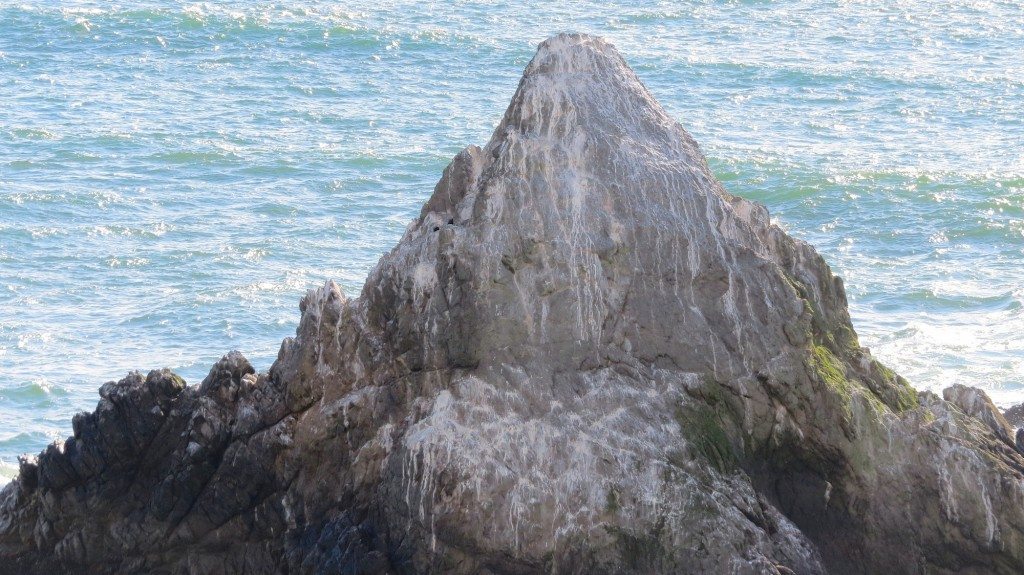
On May 20, I spotted two beautiful eggs on the nest, each a soft gray-green color, speckled with brownish-black. I wondered whether there might be a third coming. Both adults stood around, looking at the eggs, pecking around the nest site for food. One of them flew off for several minutes, and eventually the other sat on the eggs. Things were shaping up.
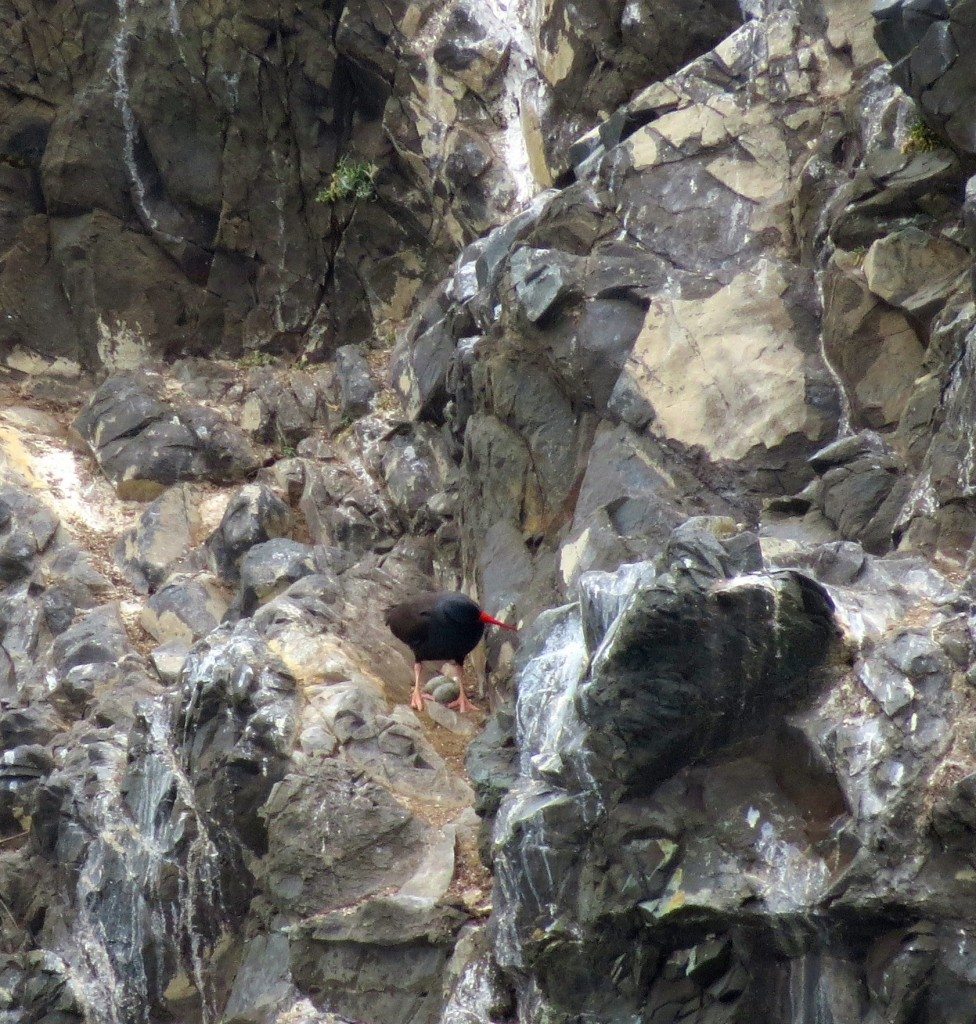
Lost and Found
I knew that oystercatcher eggs are typically laid at about 24-hour intervals, so I arrived early the next morning, May 21, hoping for a third egg. An adult was on the nest. When it finally stood up, I saw one egg on the nest and adjusted my scope for a better look. One egg. I waited. Next time the adult stood up, I looked hard, snapped some quick photos, and saw one egg. I tried different and higher viewing locations around the deck and Cliff House. No second egg. I worried the egg had been stolen. That day, Western Gulls circled in the direct vicinity of the nest, low and close, like reconnaissance experts.
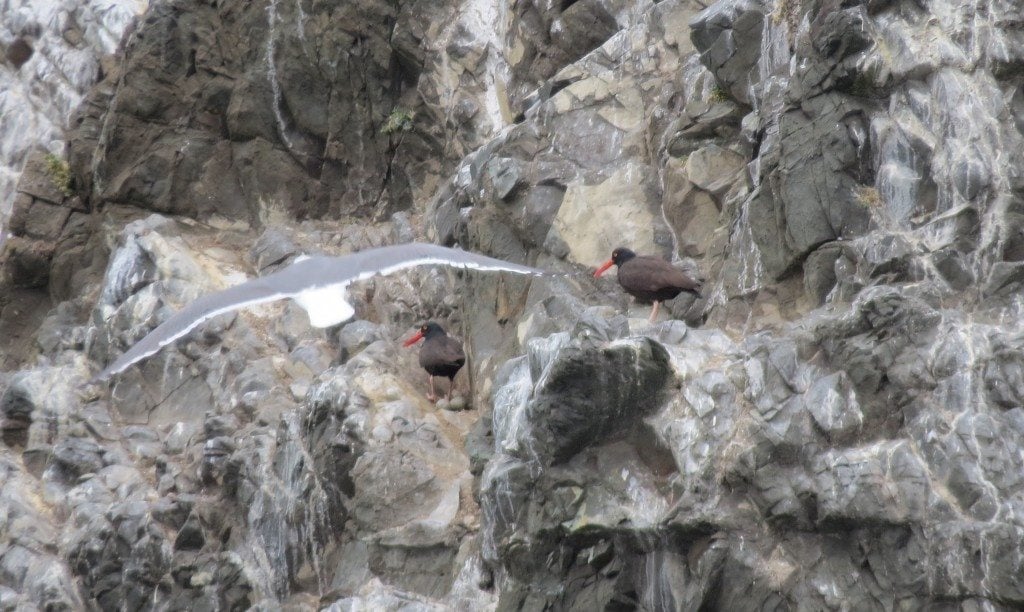
I found this period unsettling. On May 23, I once again found two eggs on the nest. I was happy and philosophical. I surmised that we lost one egg and a third egg had been laid. In the meantime, I also noticed that 20 Brown Pelicans had moved around the bend on Cone Rock, very close to the oystercatcher nest. Were pelicans predators too? I was not sure. Their bills seemed too large for such precision theft.

By May 26, there were three eggs on the nest. After looking at my nest photos carefully, I believed I solved the egg mystery. I could detect that one egg had rolled down into a deeper spot in the nest crevice and had been largely blocked from view, and thus it had been undetectable in the scope. I was happy to get that resolved, and was feeling optimistic. The oystercatchers now had three eggs, and a precision incubation regime could be now implemented. Incubation would last 28-30 days. Both the male and the female oystercatchers would share the job of incubating their eggs.

Incubation Exchanges
Now commenced an interesting time of watching the two birds working together on brooding the eggs. I became obsessed with incubation exchanges between the two. These were my brief chances to check out the status of the eggs. I liked to verify that the eggs survived the night and possible predation while I wasn’t present. The adults changed places about every 1½ hours. In the beginning, the exchanges were a little slow and a little sloppy.
On May 28, during an incubation exchange, I saw that three eggs were in the nest. Later, as one adult sat on the eggs, I heard the high piercing notes of the mate flying in toward the nest. Suddenly, both adults just flew off into the sky, and circled the island, sounding off with their wheep-wheep-wheep calls. I was stunned. What were they thinking? The three eggs on the nest, wide open, totally unprotected for two to three minutes! Were these two totally inexperienced…. reckless? I was relieved when one of the adults returned and sat on the eggs.
After that time, on subsequent visits, I did not see the eggs exposed in as careless a way again, at least during my visits. I remained a bit edgy about possible predation. But, I found that through the incubation process, the adult pair began to exhibit more seamless, smooth transitions while trading places, protecting the eggs from exposure and predators. Still, Western Gulls continued to fly over.
During periods of low tides, the adults changed incubation positions more often, like every 45 minutes, so both of them would have ample opportunity to forage for food when the mussels are exposed.
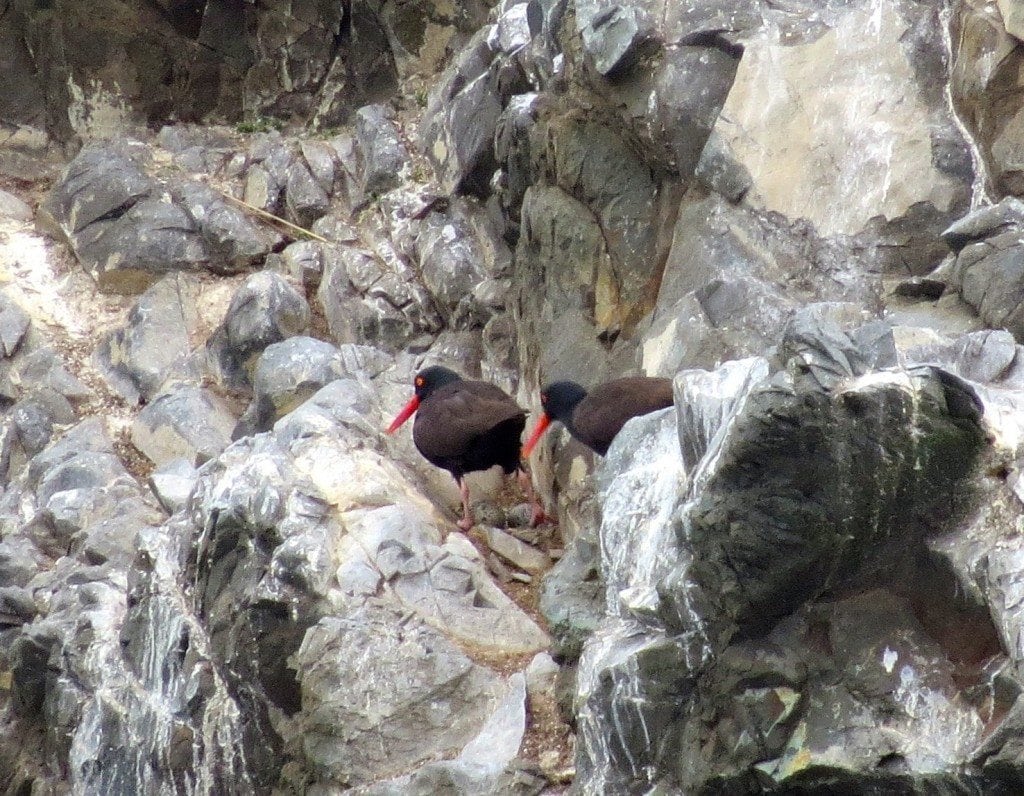
Lonely?
Peering through my scope at the birds as much as I did, I became so aware of the cumulative hours these two adults put in, day after day, sitting alone, warming the eggs. They were long hours. It’s tough duty, covering eggs under every weather condition, and uncovering them for very short breaks to stretch or change positions when both adults were near the eggs.
I wondered. Do birds get lonely? As the incubation days wore on, I thought I detected more interaction and contact during the changeovers. I saw at least two or three physical greetings, definite moments of intimacy and friendliness, when the adult pair traded places for incubation duty. You might call this a projection or wishful thinking. But photos don’t make things up.

The Big Day
On June 17, fog covered the rocky intertidal zone. Visibility was not perfect. An adult had just flown off the nest, and the other had sat down, so I’d missed my window to directly see and check out the eggs. The foraging adult returned later to the nest, and the two adults stood up looking down at the eggs. They stepped around the eggs, leaned in, and stared. During the day, I was hearing several piercing cries from the incubating and off-nest adult, more than usual. I sensed something was happening. As the day cleared, it was obvious the eggs were hatching.
I could see a small protuberance on one egg. The two adults seemed spellbound, watching the eggs intently for minutes at a time. Two of the baby chicks hatched out a few hours apart that day. They remained mostly hidden under the brooding adult, but could be spotted when the adults changed places. By my calendar, these eggs were about 30-31 days old at hatching. One more new chick hatched the next day, June 18.
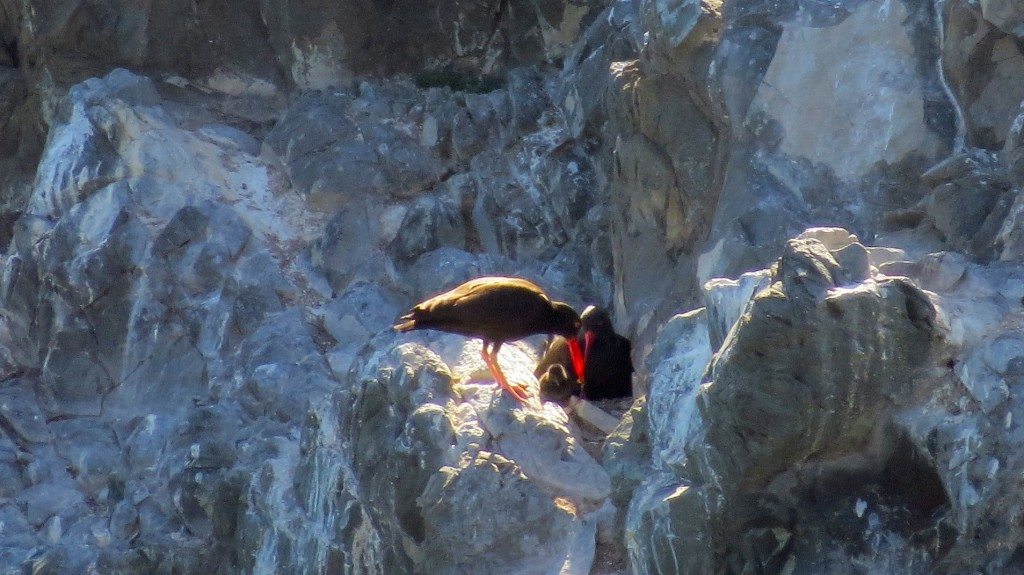
The adults kept the chicks covered and warm for the first day or two, but the chicks soon emerged, active and curious. By days two and three, the adults were flying back and forth with food for the young. One adult offered a worm to a new chick at three-to-four days old. The adults often came back with morsels that were pulled apart into smaller bits for the chicks.
Over the next five days, the chicks roamed, explored, climbed rocks, napped, and sometimes ducked under the warmth of the parent. At three-to-four days old, the chicks were heavily covered with black down. Within one week the chicks visibly grew. It was a magical time watching the family. I was not prepared for what was to come.

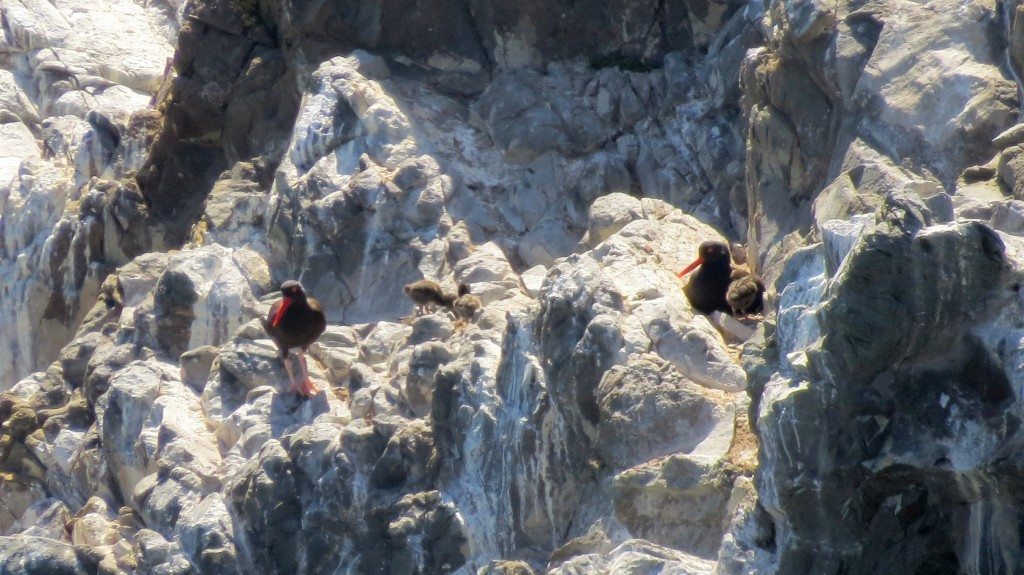
Exodus
The above photo, from June 25, was my last shot of the family at the nest site.
On June 26 at 4:15 p.m., when I arrived, no birds were visible at the nest. The family had departed. The adults had cleaned the site, leaving no trace of shells or scrapes in the nest area.
With binoculars, I scanned Cone Rock and the vicinity carefully. I spotted an adult Black Oystercatcher on Repose Rock. I followed him as the bird flew to the low southeast side of Cone Rock. This area was farther away from the scope, in more dense and rugged territory than the openly visible nest had been. The terrain was covered with dark rocks and deep crevices that formed an invisible maze of paths between them. The chicks were nowhere in sight.
In the new terrain, the chicks were particularly difficult to detect.
The two adult oystercatchers had intentionally moved the chicks down to these dark crevices. Concealment and protection from predators were probably a factor. The nest site high on Cone Rock was highly visible to gulls, raptors, and ravens. The availability of nearby food may also have motivated the move. A large necklace of mollusks and green algae circled the bottom of Cone Rock and was close at hand.
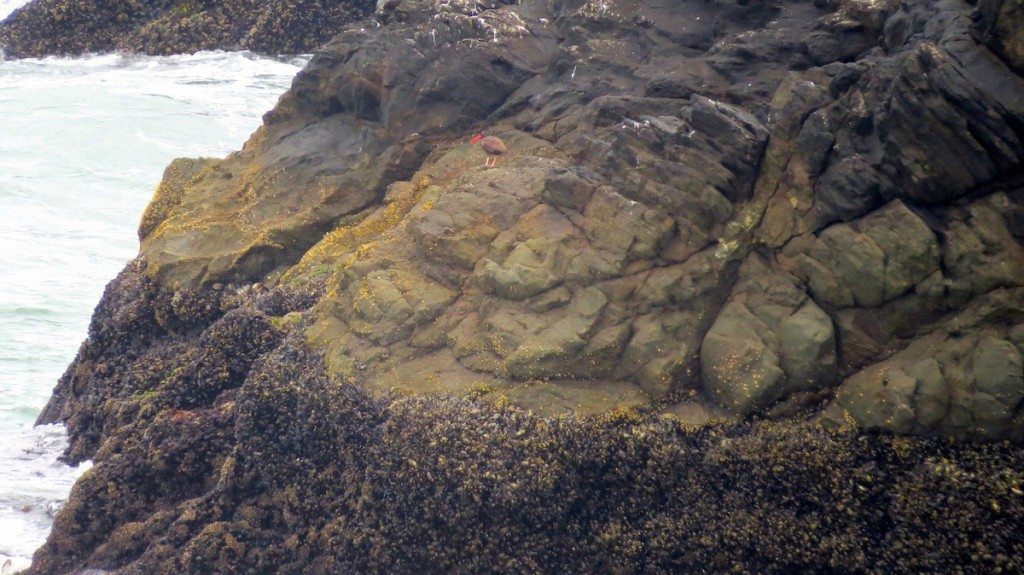
I wondered if the descent down the rock had been physically damaging for the chicks. The passage down was steep. At what time of day was the journey made? Did they leave under the cover of night?
On June 27, I knew the three chicks had made it to safety. I spotted the two adults right out in the open with the three small chicks. The chicks looked tired and two of them almost immobile, resting on the rocks.
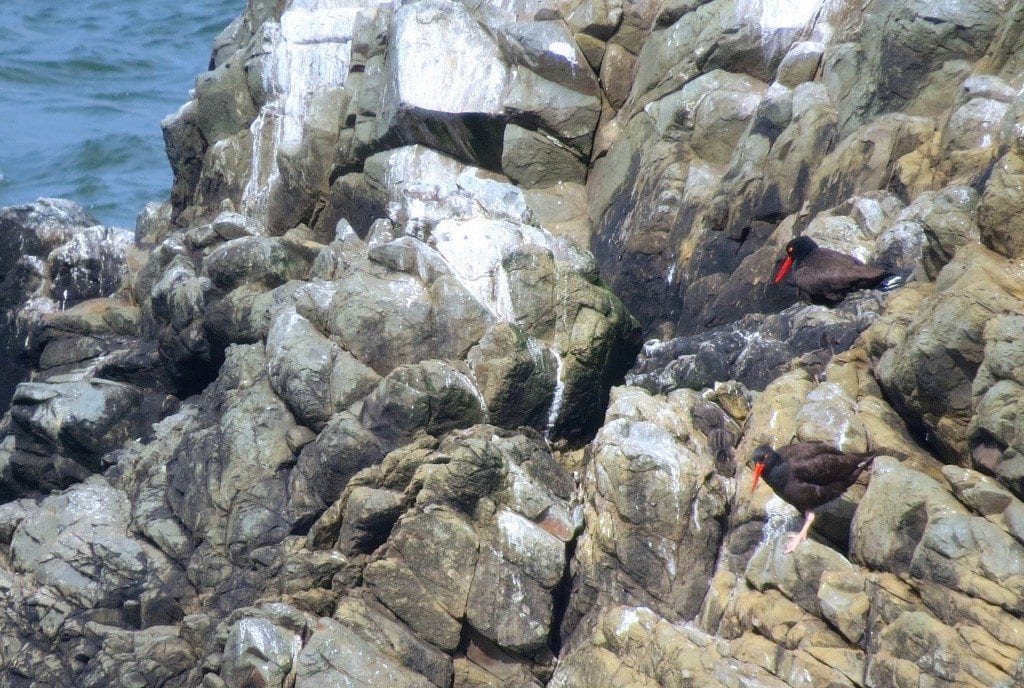
It is difficult to decipher the chicks in the photo below, but all three chicks are left and center between the two adults. It was a great relief to see them alive. The family of five had made it to the new site. But Western Gulls were cruising around with an eye on the chicks.
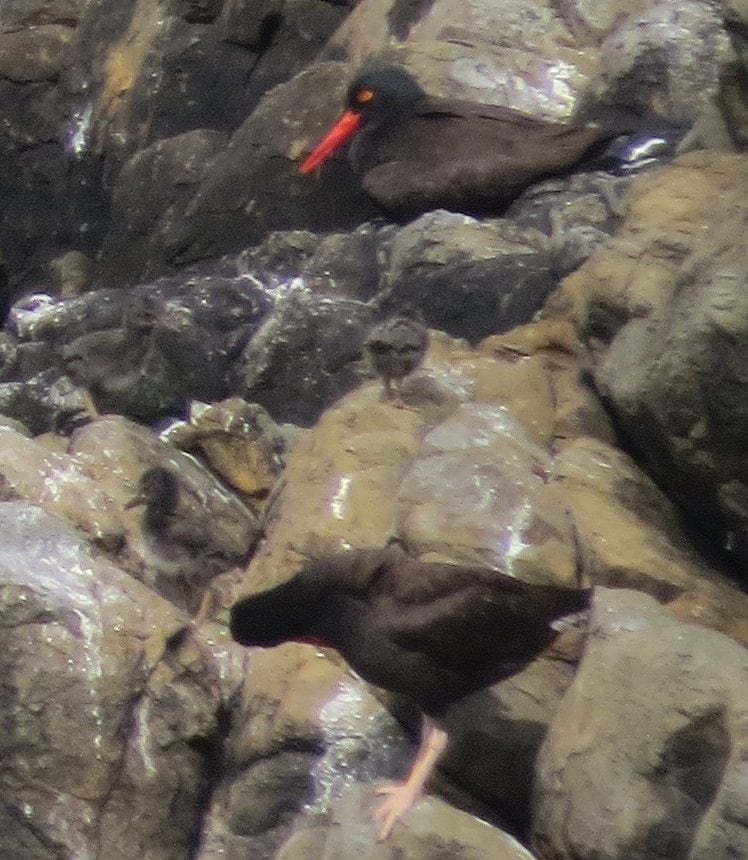
On June 29 and July 3, the adults flew in carrying bits of food, but they descended behind a rocky ledge out of sight to reach the chicks. On July 5, food from the local mussel beds was delivered four times by adults within a 15-minute period, but the number and status of chicks remained unclear. One chick emerged from the rock overhang into the open and stood with the adult delivering the food.
But then I lost two of the chicks. I did not spot them for several days. It was a week of consternation over their fate.
On July 11, right as I was about to quit for the day, I saw something surprising and unusual: Two plump-feathered chicks emerged from the rock crevices. I was surprised and taken aback. Were these the two missing chicks? At first, I thought so, but hesitated. They looked different, bigger and over-fed. I reasoned that some chicks get more food than others; some are favored or more aggressive.
When I returned home, it came to me: They weren’t Black Oystercatchers. They looked like Western Gull chicks. A quick look in Sibley confirmed my suspicions.
I couldn’t accept that the oystercatcher chicks might be dead. Was it just too difficult for the oystercatcher parents to provide for three chicks? Had the adults succumbed to feeding only the strongest dominant chick? Or had the other two oystercatcher chicks succumbed to predation? Were they hiding? Starving?
Then I discovered a pair of adult Western Gulls were nesting right in the vicinity of the oystercatchers’ new home on the southeastern side. Three plump gull chicks began to appear regularly, and they aggressively followed the two adult oystercatchers and their one remaining juvenile around Cone Rock. Within a few days of this behavior, the adult oystercatchers and the juvenile moved to a sheltered area further south, and the adults began to lead the juvenile to the western side of Cone Rock to forage some distance away for several days. The gull chicks did not follow.
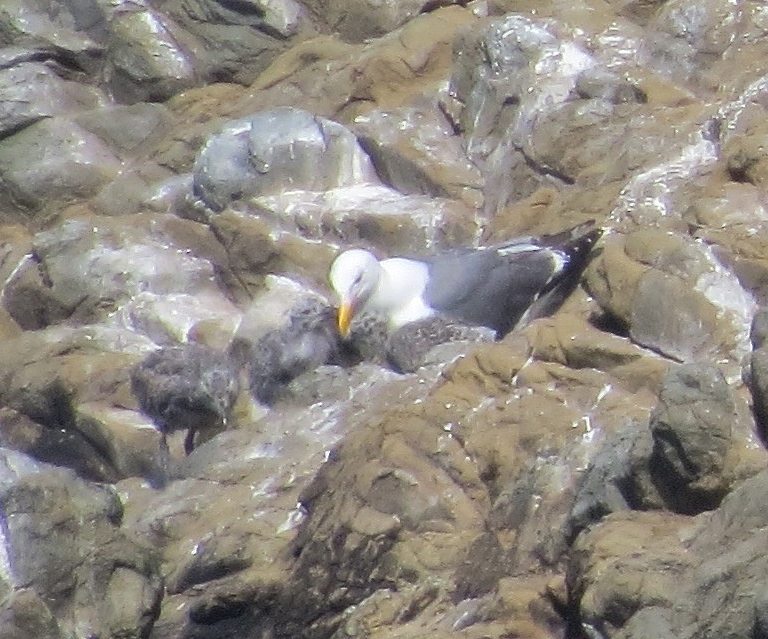
The Western Gull adults may well be the predator that killed the two missing Black Oystercatcher chicks. One day in early July, I witnessed a scene that happened very quickly. It was distressing to watch. The two parent/adult Western Gulls were frequenting the new neighborhood of the oystercatchers. The two adult oystercatchers and the growing juvenile had just begun to take walks out on visible routes on the island; at this time, the juvenile always was placed in middle of the two adults, one adult leading, one guarding the back. There had been no sign of the other oystercatcher chicks.
One of the Western Gulls called in the gull chicks. The three Western Gull chicks hurried in and pressed close against the adult, who held in his bill, what looked like a 2-3 inch strip of white flesh or fish. The chicks snapped and pulled at the food, ripping off pieces. The crowd of activity made it impossible to see what was being eaten. However, about 12 feet away, and north, I saw the two oystercatcher adults and the one juvenile walk up out of the depths of the rocky terrain, step up the path about six feet, then turn around to look down on the feeding frenzy. They looked long and hard. The closest adult moved down the path towards the commotion, disappeared into the rocks for three minutes, and then reappeared. Minutes later the oystercatcher family turned up and to the north and hiked up the path to an area higher up on the rock.
Adult Western Gulls were flying by more often. I worried about the vulnerability and safety of the one remaining juvenile. The adults appeared to be vigilant when I was watching. Looking ahead, I wondered: When would the juvenile fledge?

Fledging
During July, the adult oystercatcher pair and juvenile began to hike up daily to a large, concave, flat field of rock on the south side of Cone Rock area. There had been no signs of flight from the juvenile.
Watching these daily hikes, it occurred to me that this wide-open space was a perfect safe flight field for the juvenile to experiment with flying. The adults would lead and leave the juvenile in the middle of the smooth concave area. They climbed up nearby on high rocks and looking out over the arena where the juvenile sat. For a few days, the juvenile did very little, sat there, and took a few steps, exploring around the rocks a bit.
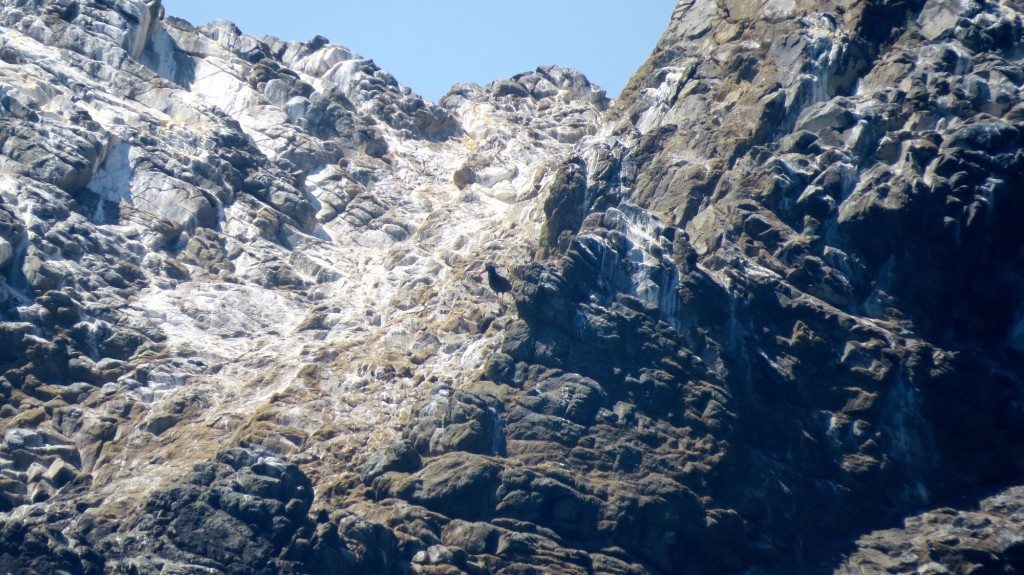
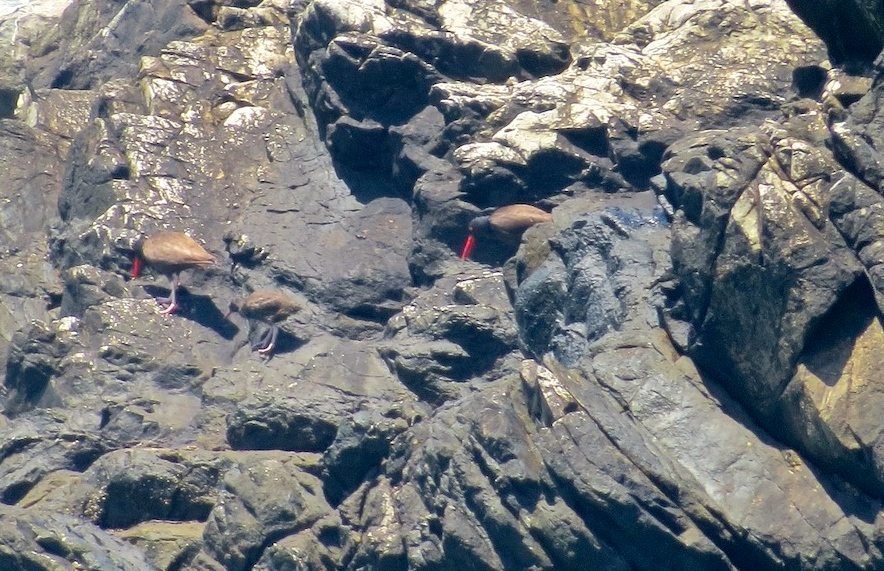
Then one day, as the adults headed down with the juvenile trailing behind, the juvenile stopped, opened its wings and flapped vigorously three or four times. It was both comical and satisfying to see. It was like a first grader on a two-wheeler riding for the first time, weaving madly to the left, then the right, on a concrete playground. It was July 25. The juvenile was 39 days old. There was no take-off, but definite signs of interest and readiness for flight.
The very next day, the threesome hiked up a steep rock and the juvenile stumbled and slid back off the rock into a path below. Then he quickly flapped its wings and reclaimed his footing on the rock above. Progress was being made.
Black Oystercatchers are ready for flight at about 38-40 days. But after they fly, they stay close within their parents’ territory for some time, four to five months or more, primarily due to their dependence on the parents to help them forage. It takes extended time for juveniles to master opening the tough hard mollusks they depend on for food.
On August 3, the two adults and the juvenile were up on top of Cone Rock. The juvenile is the lowest of the three on the rock. Here the juvenile was practicing flapping its wings. It is 48 days old. This photo represents my last sighting of the oystercatchers on Cone Rock.

On August 18, I heard and then found the family of three oystercatchers foraging about a quarter mile north of Cone Rock, on the sandy shore of a small private cove. One adult was extracting marine worms farther down the beach. The other adult and the juvenile were below me on the wet sand, running forward quickly, digging into the wet sand, then dashing back to avoid the cold seawater, hunting for worms together. Later, up on the rocks, one adult brought some morsels to the juvenile.
In mid-August, the two adult Black Oystercatchers and the juvenile moved north to an offshore rock above Pt. Lobos, off the western cliffs of the Land’s End Trail. The juvenile hiked among the rocks and foraged for small edibles, preening and flapping its wings. The adults continued to forage and bring morsels to the juvenile. My last sighting was the juvenile flying up about 15 feet to a ledge above. She or he was fully on its way.
It’s surprising how quickly these four months passed. I made over 40 trips to the edge of rocky Land’s End. With the power and clarity of a Swarovski scope, transported and sitting nest side, I found myself slowly pulled into the life and drama of two birds and three chicks. I often went away from my visits feeling impressed with the steadiness of the parents, and their unending work of warming, watching, foraging, and feeding their chicks to help them thrive. I’ve come away with a strengthened interest, feeling, and respect for the full, complex lives of birds and other animals besides our own species.
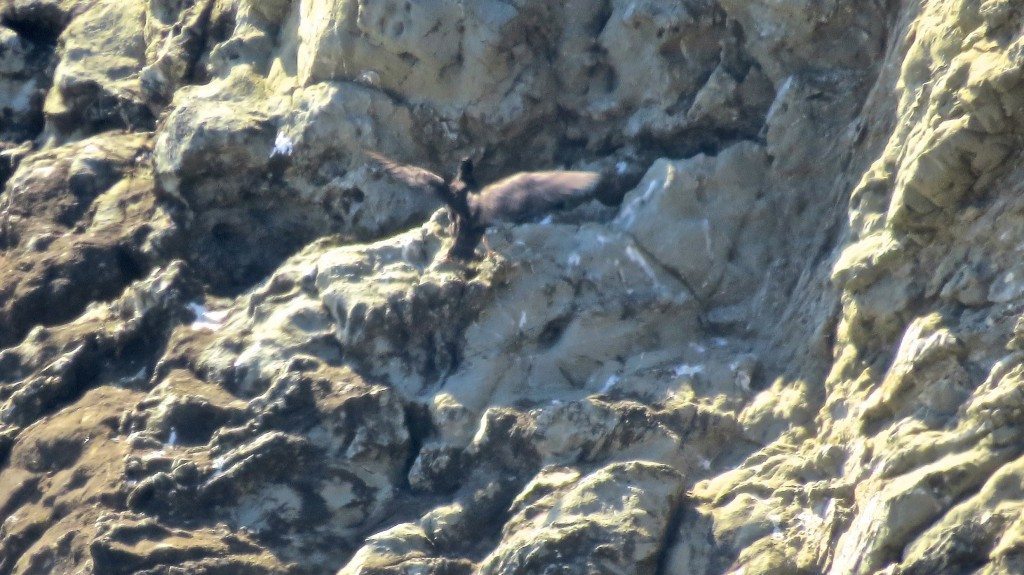
Postscript
Recently it has been recognized that the Black Oystercatcher faces several challenges. One is their dependence year-round on the relatively sparse rocky-intertidal habitat for their livelihood.
This habitat is a rugged and tough environment, vulnerable to rising sea levels, to warming sea surface temperature, to oil spills, and to human use and disturbances along the shore. Another challenge, mentioned earlier, is that the survival rate of Black Oystercatcher young appears to be dropping.
A 2011 population assessment of Black Oystercatchers along the California coastline estimated a statewide population level that was proportionally larger than what had been previously assumed. Weighing results from a 2011 survey and population estimates from the birding literature, the researchers concluded that a very high number of the remaining individuals of this species — between 4,749 and 6,067 — live and nest here on the Pacific Coast, many in California. In other words, the quality of our coastal resources and how we care for them and protect them from disturbance becomes not just important, but critical, in the survival of the Black Oystercatcher.
How can we help
California’s rocky coastal habitat is a place of extraordinary beauty, prized by locals and a large number of visitors. The Black Oystercatcher is most vulnerable during its nesting season from April-June. Human disturbance (scrambling on rocky cliffs, or through beach grass) can be a big threat. Oystercatcher nests and eggs are difficult to see. An adult oystercatcher scared off its nest leaves its eggs or chicks exposed to harsh elements, thermal decline, and predation.
In the long run, we can help protect oystercatchers by reducing carbon emissions that contribute to climate change, and by preserving coastal habitat. In the short run, we need to avoid disturbing their nesting sites when visiting the coast. We also need to improve education and outreach throughout the coastal range. As seabird ecologist Laurie Harvey said to me: “A simple sign: ‘Nesting Birds, Go No Further,’ would be ideal, but very difficult to achieve.”
For more information, see Audubon California’s page on Black Oystercatchers.
All the photos accompanying this article are by Jane Turner Hart.
———————————————-
Jane Turner Hart is a graduate of the 2014 Master Birding class co-sponsored by the California Academy of Sciences and Golden Gate Bird Alliance. As a volunteer for Golden Gate Bird Alliance, Jane has monitored Burrowing Owl and Black Oystercatchers, and raised funds for the 2014 Birdathon. A Berkeley native, Jane has lived a stone’s throw from Golden Gate Park with her husband Kevin for the past 22 years.
